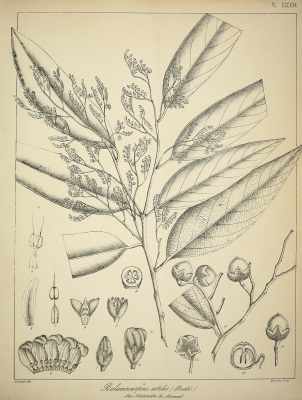Hopea utilis
(Bedd.) Bole
Dipterocarpaceae
Balanocarpus utilis Bedd.
Common Name:
General Information
Hopea utilis is an evergreen tree growing 18 - 24 metres tall. The bole can be 50 - 150cm in diameter[
].
The tree is harvested from the wild for its timber.
The tree has a small native range and is threatened by habitat loss. It regenerates copiously around the parent tree. It is classified as 'Endangered' in the IUCN Red List of Threatened Species(2011)[
338- Title
- IUCN Red List of Threatened Species
- Publication
-
- Author
-
- Website
- http://www.iucnredlist.org/
- Publisher
-
- Year
- 0
- ISBN
-
- Description
- A list of plants under threat and facing possible extinction, usually with brief details of the threats and information on habitat.
].
Known Hazards
None known
Botanical References
Range
E. Asia - southern India.
Habitat
A canopy tree in semi-evergreen forests, usually near large rivers, at elevations from 200 - 850 metres[
,
884- Title
- The World List of Threatened Trees
- Publication
-
- Author
- Oldfield S.; Lusty C.; and MacKinven A.
- Website
- http://www.biodiversitylibrary.org
- Publisher
- World Conservation Press; Cambridge UK
- Year
- 1998
- ISBN
- 1-899628-10 X
- Description
- A list of the trees on the IUCN Red List of Threatened Plant Species in 1998, often giving some information on habitat and the reasons for being on the list. It can be downloaded from the Internet.
].
Properties
| Conservation Status | Endangered |
| Other Uses Rating |      |
| Habit | Evergreen Tree |
| Height | 20.00 m |
| Growth Rate | Slow |
| Pollinators | Insects |
| Cultivation Status | Wild |
Cultivation Details
A plant of the moist, monsoonal tropics, where it is found at elevations from 200 - 850 metres. It grows best in areas where annual daytime temperatures are within the range 24 - 33°c, but can tolerate 10 - 38°c[
]. It can be killed by temperatures of 8°c or lower[
]. It prefers a mean annual rainfall in the range 2,500 - 3,500mm, but tolerates 1,400 - 4,300mm[
].
Young plants can tolerate heavy shade, though need more light as they grow larger[
]. Prefers a medium to light, well-drained soil[
]. Prefers a pH in the range 5 - 6, tolerating 4.5 - 6.9[
].
A slow-growing species[
338- Title
- IUCN Red List of Threatened Species
- Publication
-
- Author
-
- Website
- http://www.iucnredlist.org/
- Publisher
-
- Year
- 0
- ISBN
-
- Description
- A list of plants under threat and facing possible extinction, usually with brief details of the threats and information on habitat.
,
884- Title
- The World List of Threatened Trees
- Publication
-
- Author
- Oldfield S.; Lusty C.; and MacKinven A.
- Website
- http://www.biodiversitylibrary.org
- Publisher
- World Conservation Press; Cambridge UK
- Year
- 1998
- ISBN
- 1-899628-10 X
- Description
- A list of the trees on the IUCN Red List of Threatened Plant Species in 1998, often giving some information on habitat and the reasons for being on the list. It can be downloaded from the Internet.
].
Trees are sensitive to forest fires[
].
Edible Uses
None known
Medicinal
None known
Other Uses
Wood[
146- Title
- A Manual of Indian Timbers.
- Publication
-
- Author
- Gamble. J. S.
- Publisher
- Bishen Singh Mahendra Pal Singh
- Year
- 1972
- ISBN
- -
- Description
- First written in the 19th century, but still a classic, giving a lot of information on the uses and habitats of Indian trees. Not for the casual reader.
]. A valuable timber[
146- Title
- A Manual of Indian Timbers.
- Publication
-
- Author
- Gamble. J. S.
- Publisher
- Bishen Singh Mahendra Pal Singh
- Year
- 1972
- ISBN
- -
- Description
- First written in the 19th century, but still a classic, giving a lot of information on the uses and habitats of Indian trees. Not for the casual reader.
].
Propagation
Seed -
If you have any useful information about this plant, please leave a comment. Comments have to be approved before they are shown here.


 Useful Tropical Plants Database 2014 by
Ken Fern,
web interface by
Ajna Fern
with help from
Richard Morris.
Useful Tropical Plants Database 2014 by
Ken Fern,
web interface by
Ajna Fern
with help from
Richard Morris.